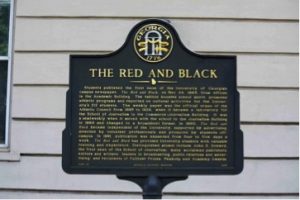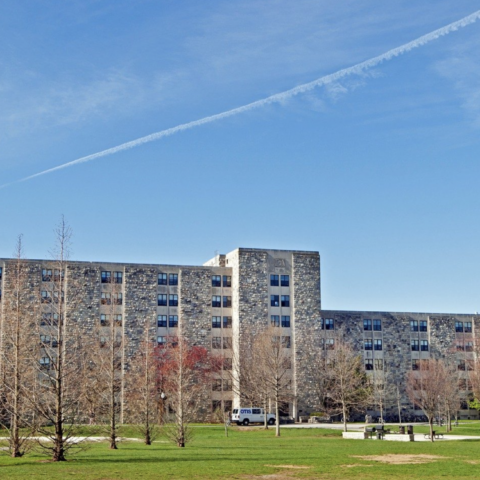By: Emily Kopp
This Monday, two student editors of UGA’s newspaper, The Red and Black, conferred with members of the board of directors in a meeting to determine the future of one of the nation’s premier college newspapers and a longstanding campus institution.
Editor in Chief Polina Marinova and Managing Editor Julia Carpenter leveraged their interviews Monday as a venue to push for written confirmation that students will retain control over Red & Black content.
In a joint statement that bodes well for the continued integrity of The Red and Black, Marinova and Carpenter said they had been reinstated to the positions they resigned last Wednesday and affirmed that “students have editorial control over our publications with no prior review.”
The previous Friday afternoon, a congregation of student journalists, professional journalists and J-school professors stood outside the The Red & Black offices under the hot glare of the August sun awaiting the decision of a board of mostly non-journalists on an issue of media integrity.
Flanked on all sides by reporters, Board Vice-Chair Melita Easters read a somewhat vague statement regarding prior review.
The prepared statement, as available on The Red & Black website, reads, “[t]he student editor has always had the final editorial decision responsibility for our news content. That is still the case.”
Easters did not acknowledge that the board had days earlier effectively revoked that responsibility by authorizing the editorial advisor to change and censor articles at whim.
Soon after Ed Morales, whose promotion to editorial director in part prompted the editorial staff’s collective resignation, introduced himself as the “editorial advisor,” an announcement met by applause and cheers from the assembled crowd.
While the board has backed down on the most glaring issue of students retaining editorial control, questions remain about the continued influence of hired staff on coverage and student representation on the board—questions that will undoubtedly be hashed out in the coming days.
The commotion of the last week, which made ripples as far as the New York Times, might be chalked up by some as the board unfairly pointing the finger at paper’s content for flagging circulation, when a brutal market for local news should really shoulder the brunt of the blame. But that narrative obscures the simple fact that criticism of The Red & Black has grown more vocal in the last year, following the paper’s departure from the custom of putting out a print paper five days a week to an online focus and a weekly paper.
Casual Red & Black readers complain the paper has increasingly published controversial stories that border on salacious. Carpenter’s front page spread in the spring about Adderall use on campus—paired with the headline “It’s like legal coke”—in particular garnered criticism. The paper has also long wrestled with its “anti-Greek” image, which alienates it from a significant portion of the student body. Some students disapprove how the police blotter’s colorful stories about setting deer heads on fire and other hijinks portrays the University, and charge that covering arrests betrays students’ privacy.
I suspect the board’s push for greater professional control of the paper gained urgency with the recent misunderstanding over the Opinions column “How to find the perfect husband in college,” which touched off something of a firestorm on Jezebel, Reddit, and elsewhere this summer.
Their efforts, however, are ill-conceived. If the board wants better content, it needs to sustain an environment at The Red & Black that welcomes creativity, even when it goes terribly, terribly wrong. If bright writers and editors feel micromanaged or stifled, they can always channel their efforts and develop their talents through some other alternative online publication, (see: the Red & Dead blog, as whipped up in a couple of hours).
Grady College supplies The Red & Black with some of the best trained student journalists in the country. Not that their contributions will always be perfect. The Red & Black serves as a much as a learning device as a stand-alone publication, as its mission statement makes clear.
The perceived move towards “salacious” stories reflects the editors’ attempt to broach a bridge to students disconnected from campus news by the multitude of distractions available to them—iPods, Tumblr, Hulu, Netflix, 4chan, etc.—albeit with some growing pains.
The Red & Black staff has worked to address lingering student concerns about the paper. The front page of the year’s first print paper prominently featured sorority rush, for example. Journalists have long been criticized as breaching privacy in their coverage of arrests; for The Red & Black to concede to those criticisms would be to break a time-honored media tradition of bucking them.
Unfamiliar middle-aged men have been middling around The Red & Black offices all summer, apparently trying to devise a sustainable business model for the paper. I suppose they should not be faulted for that. But the tone of resigned Board Member Ed Stamper’s now infamous memo suggests a dismissive, almost condescending attitude towards the students that staff the paper among the adults charged with overseeing operations.
The memory of Conrad Fink, a Newspapers professor and former AP reporter who passed in January, was often invoked in the last week by people in support of the resigned students, including Grady Professor Barry Hollander in his blog post on the walkout and Red & Black alumnus Yasmin Yonis in her Red & Dead letter to the editor.
A stalwart for unfettered freedom of the press, Professor Fink represents the importance of ethical journalism in the eyes of many Grady students.
But Professor Fink was not a doe-eyed, out-of-touch idealist; he also had a keen eye for media business strategy and an unending interest in the industry’s future.
He believed that real journalism, stories that challenged the institutional status quo, not only served an ethical purpose but served the bottom line as well. He also trusted the judgment of his students.
In his Newspaper Management class, discussion foremost concerned how to make journalism viable in a digital era. We always came up empty-handed for answers, but Professor Fink seemed unwavering in his confidence that we had one.
That trust in young, coming-of-age journalists will serve the board well, should they continue to embrace it.

